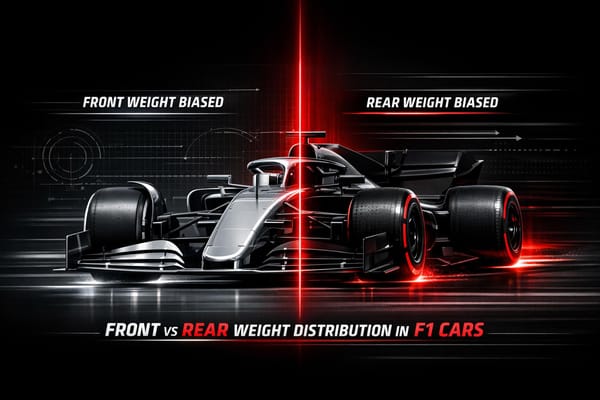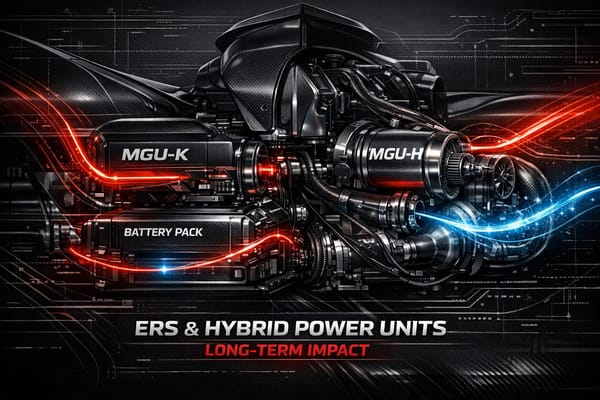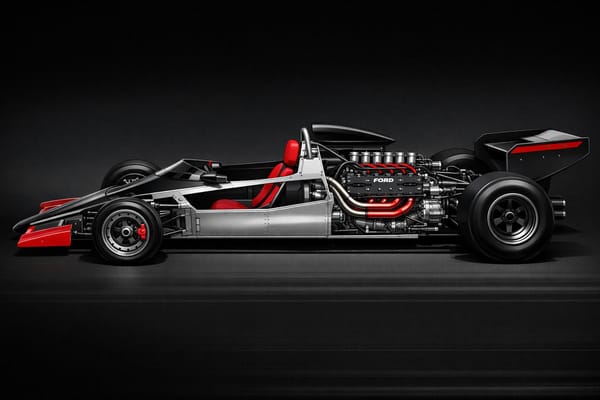Bright Lights, Big Risks: F1’s Las Vegas Grand Prix Returns for 2025
The Las Vegas Grand Prix for 2025 promises high-speed thrills, unique race strategies, and an unforgettable fan experience in a vibrant night setting.
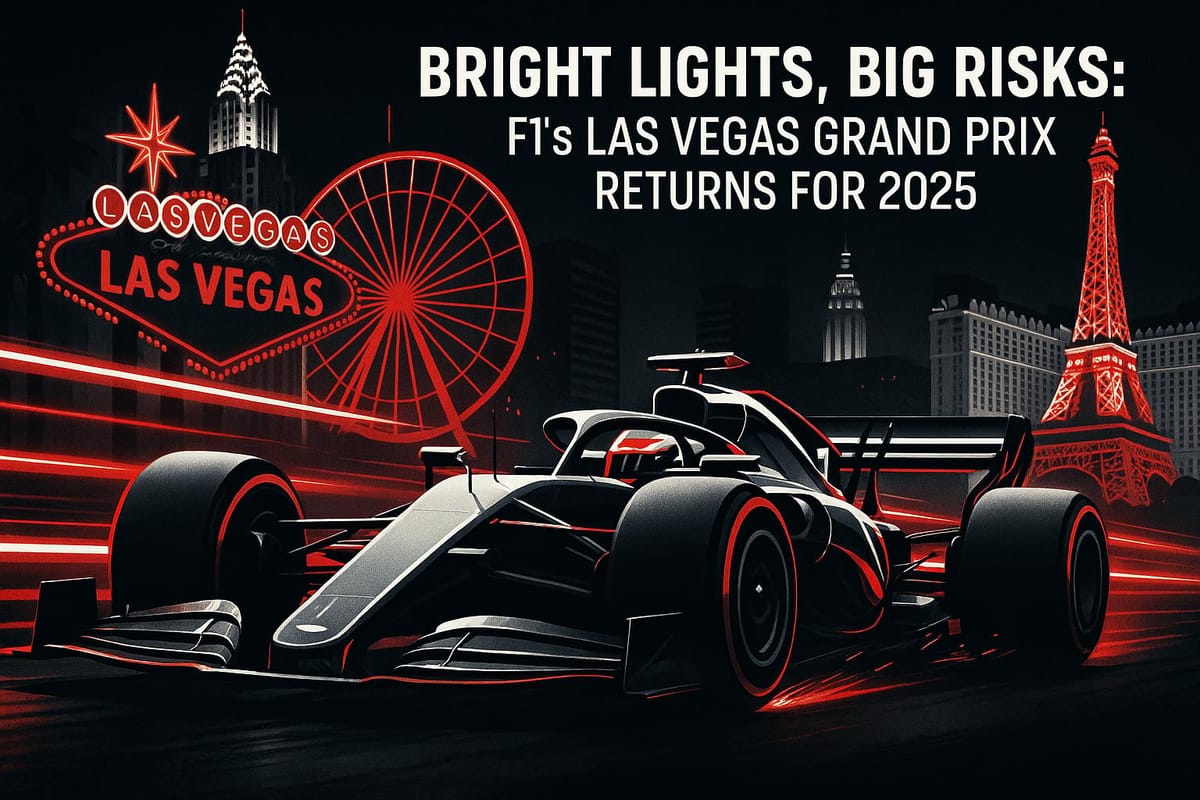
The Las Vegas Grand Prix is back for 2025, combining high-speed racing with the city's iconic nightlife. The 3.8-mile circuit on the Las Vegas Strip features 17 turns and a 1.9-kilometer straight where cars can hit speeds of 217 mph. This race stands out for its late-night schedule, unpredictable strategies due to track conditions, and a vibrant fan experience. Compared to Monaco's narrow, precision-focused layout and Singapore's technical challenges, Las Vegas prioritizes overtaking and entertainment. With growing U.S. fan interest, this event is shaping the future of Formula 1 in America.
Key Highlights:
- Circuit Length: 3.8 miles (Las Vegas), 2.07 miles (Monaco), 3.07 miles (Singapore).
- Focus: High-speed straights (Las Vegas), precision driving (Monaco), technical challenges (Singapore).
- Fan Experience: Vegas nightlife, Monaco's exclusivity, and Singapore's urban entertainment.
This race blends speed and spectacle, making it a standout addition to the F1 calendar.
1. Las Vegas Grand Prix
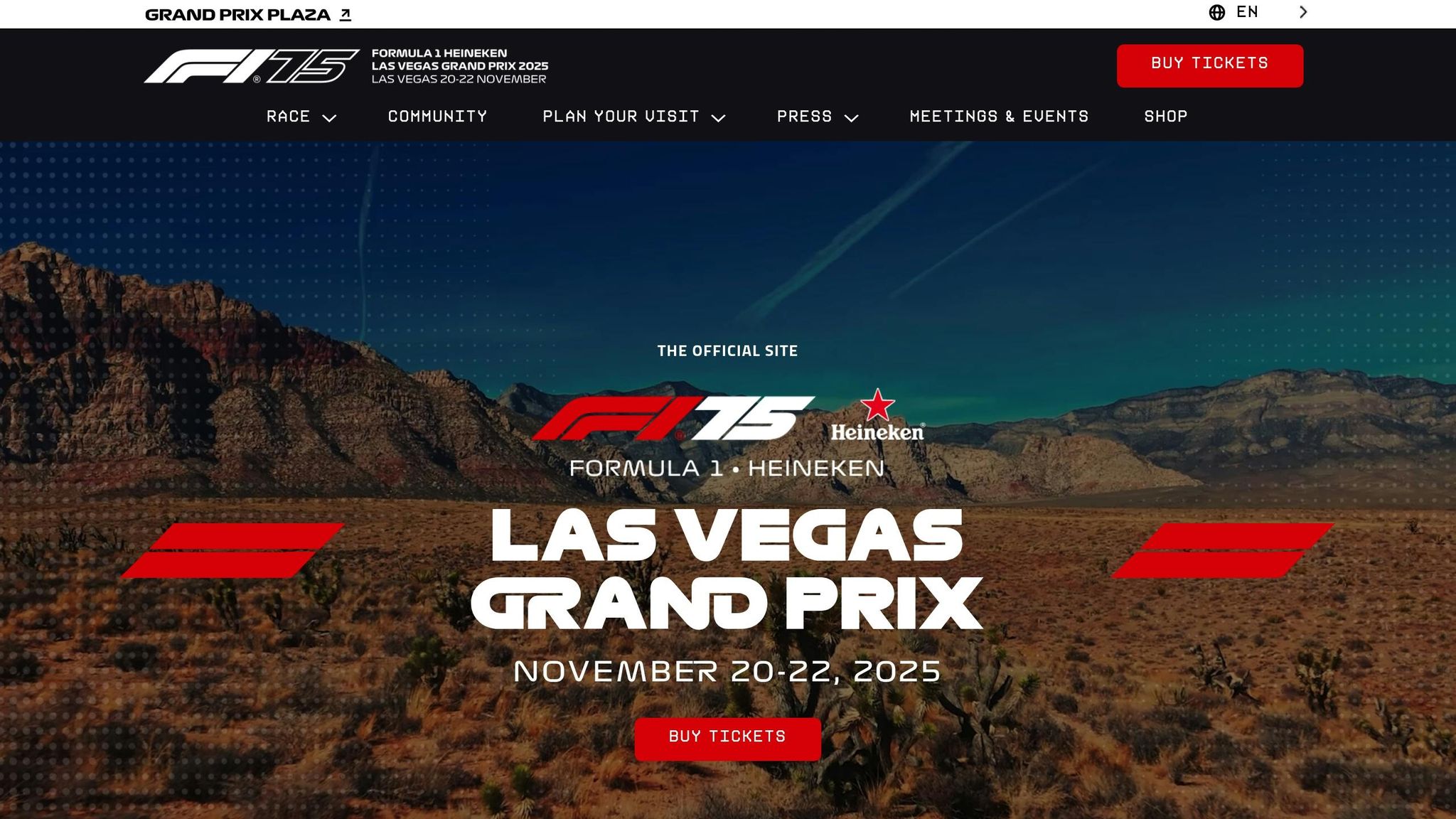
Circuit Design
At 6.201 kilometers, the Las Vegas Grand Prix circuit is the second longest on the Formula 1 calendar, offering a mix of challenges not typically found on street circuits. One standout feature is its impressive 1.9-kilometer main straight. During the last race, drivers hit top speeds of 350 km/h (217 mph) on this stretch, creating prime opportunities for overtaking with the help of DRS and slipstreaming.
The track surface adds another layer of complexity. According to Mario Isola, Pirelli's Motorsport Director, "the track is still very dirty and it gets significantly quicker with every passing lap" because it reopens to city traffic between sessions. This constant evolution keeps teams on their toes, requiring frequent adjustments to setups and strategies throughout the weekend.
These unique track conditions play a significant role in shaping race strategies and tire management approaches.
Race Strategies
Racing under the Vegas night sky brings its own set of challenges, particularly when it comes to tire strategies. Pirelli predicts most teams will lean toward a one-stop strategy, favoring medium and hard tire compounds. However, the cool nighttime temperatures make it tricky to get tires up to their optimal performance range, often leading to early graining.
"The main challenge on the tyre front will be warm-up, especially during qualifying and for the front axle in particular." - Pirelli
This difficulty with warm-up also makes early pit stops for an undercut less effective.
"Because of the difficulty in warm-up, pitting early to try and make up places with an undercut is not very efficient and in fact, on paper, going longer is a better choice." - Pirelli
Adding to the complexity is the near certainty of a Safety Car deployment, with a 100% probability recorded. Teams must stay flexible, as race interruptions can completely alter tire strategies. While the soft compound tires aren’t suited for the entire race, they might come into play during short sprints following a Safety Car period. Teams further down the grid may opt for a reverse strategy - starting on hard tires and switching to mediums for a stronger finish. Most teams are expected to have two sets of hard tires available for this purpose.
Fan Experience
The Las Vegas Grand Prix isn’t just about the racing - it’s an entire entertainment spectacle. With a 10:00 PM start time, fans can soak in the electric Vegas nightlife while enjoying a race under the glow of the city’s iconic neon lights. Demand for this event is sky-high; tickets for Saturday’s 2024 race sold out within hours.
The race weekend offers plenty to keep fans engaged. Dedicated fan zones feature live performances, exclusive merchandise, prize giveaways, and F1 simulators. Each area showcases different artists and activities, ensuring there’s something for everyone. For those seeking a premium experience, options like the Paddock Club deliver unforgettable moments. In November 2024, Alan Xu from Sacramento spent over $10,000 on a Paddock Club ticket, which included meeting Oscar Piastri - a memory he described as "absolutely amazing".
"It's been super cool. I've been to other races and they've been a bit boring, but Las Vegas is different." - Ashley Johnson from London
The combination of thrilling racing, unpredictable strategies, and a vibrant fan experience makes the Las Vegas Grand Prix a standout event on the Formula 1 calendar.
2. Monaco Grand Prix
Circuit Design
Monaco's circuit is the polar opposite of Las Vegas' high-speed, overtaking-friendly layout. Known for its narrow, twisty streets bordered by unforgiving Armco barriers, Monaco is the tightest track on the Formula 1 calendar. There's absolutely no room for error here, making precision an absolute must.
The iconic layout has barely changed since Formula 1's early days, cementing Monaco's reputation as a race where overtaking is a rare spectacle. Unlike modern circuits with spacious run-off areas, Monaco punishes even the smallest mistakes. These unique challenges demand carefully tailored strategies, making every lap a masterclass in skill and focus.
Race Strategies
In Monaco, starting position is everything. With overtaking nearly off the table, a strong qualifying performance can make or break a race. Pit stops become a chess game, as teams meticulously plan their timing to gain even the slightest advantage. Tire management is another key factor. The constant twists and turns put a heavy load on tires, requiring a delicate balance between grip and durability. Drivers must also maintain laser-sharp focus throughout the race - one slip could end in the barriers.
Fan Experience
Monaco offers a racing experience unlike any other. While the track is a challenge for drivers, it’s a treat for fans who enjoy the race from balconies, rooftops, or even luxury yachts. The Mediterranean sun and elegant atmosphere create a vibe that’s as much about glamour as it is about racing.
Where Las Vegas brings a party-like energy aimed at a broad audience, Monaco exudes sophistication. Its exclusivity, combined with limited seating and high demand, makes it a bucket-list event for racing enthusiasts. The setting perfectly complements the prestige and history of this legendary race.
3. Singapore Grand Prix
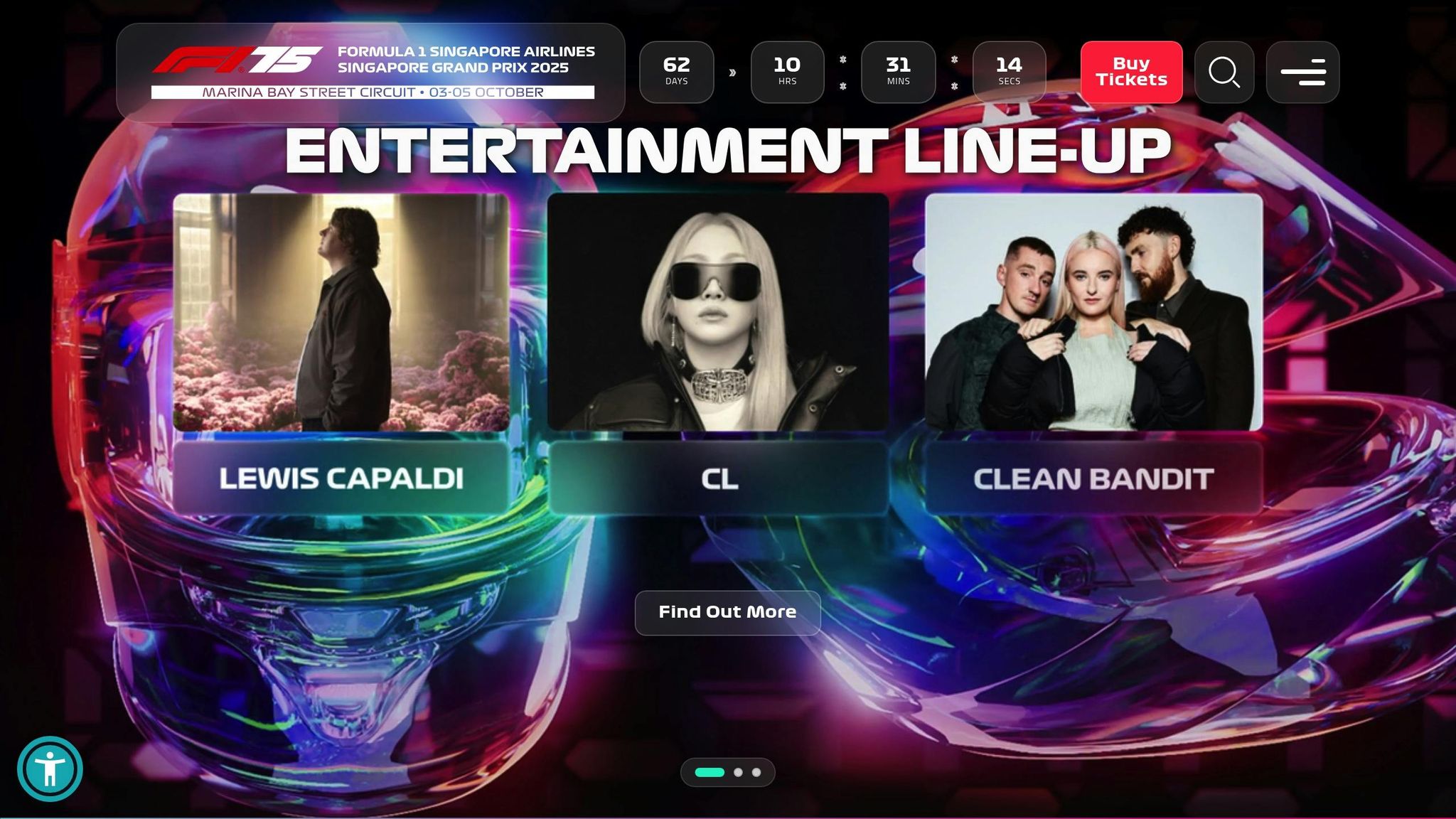
Circuit Design
The Marina Bay Street Circuit in Singapore offers a stark contrast to the high-speed, overtaking-friendly layout of Las Vegas. Spanning 3.15 miles (5.06 km) and featuring 23 corners, this track is infamous for its tight and technical design, which leaves little room for overtaking. However, Fernando Alonso has remarked that overtaking here is slightly more feasible compared to other similarly tight circuits. This challenging layout forces teams to rethink their strategies, as the circuit demands precision and adaptability.
Race Strategies
Singapore’s unique circuit design significantly influences race strategies. With a 28-second time loss in the pit lane, teams typically lean toward a one-stop strategy, unlike the multiple pit stops often seen elsewhere. Tire management becomes a critical factor, as Mario Isola from Pirelli explains:
"From an initial analysis, a medium-hard scenario is the quickest route, with a pit stop window between laps 21 and 27"
Some teams might take a more aggressive approach, starting on soft tires. According to Isola:
"The soft tire is a viable option for the first stint, with an earlier stop between laps 14 and 19 to take on the hard tire"
Drivers starting further back may gamble on hard tires, aiming for a long first stint while hoping for a safety car intervention, which has a 50% probability during the race. This unpredictability forces teams to remain flexible, as Isola points out:
"Having said all that, on this type of track, we have often seen, not least last year here, drivers and teams playing tactically with their race pace, especially on the first stint"
Fan Experience
While the teams battle it out on the track, the Singapore Grand Prix offers fans an unforgettable experience off the circuit. The event is known for its vibrant atmosphere, featuring live performances by top musical acts and engaging activities for fans. After the race, celebrations continue with spectacular fireworks displays and concerts by renowned artists, making it a weekend to remember. Multiple stages throughout the venue ensure there’s something for everyone, while fan forums provide a rare opportunity to interact with F1 drivers and team principals. Singapore’s ability to combine thrilling on-track action with immersive entertainment sets a high standard for urban circuits, offering a blueprint for enhancing race weekends at other venues.
2025 Las Vegas Grand Prix F1 Update
Advantages and Disadvantages
Each Formula 1 circuit brings its own mix of challenges and thrills, shaping the competition and the overall experience for fans and teams alike.
Las Vegas is a dream for cars built for speed. Its high-speed straights and heavy braking zones create plenty of overtaking opportunities, making the race thrilling and unpredictable. But here’s the catch: Las Vegas hosts the priciest tickets on the F1 calendar. The nighttime race, set against the dazzling lights of the entertainment capital, offers an unforgettable visual spectacle. However, this focus on glitz and glamour comes at the expense of the raw racing purity some fans cherish.
Monaco stands as the epitome of F1’s tradition and prestige. The 2.07-mile circuit demands flawless precision from drivers, with its narrow streets and barriers leaving zero room for mistakes. While the exclusivity and legendary parties make it a bucket-list destination, the cost of staying in Monaco is prohibitive for most fans. To balance things out, the free Fan Zone at Place D'Armes - featuring live music, interactive displays, and driver interviews - offers a more accessible way to soak up the atmosphere .
Singapore is a mix of technical racing and urban entertainment. The 3.07-mile Marina Bay circuit, with its 19 tight turns, challenges drivers to stay razor-sharp, as even small errors can be punishing. Beyond the track, Singapore excels at blending high-octane racing with vibrant nightlife, dining, and shopping, all conveniently close to the venue. While the event’s economic impact is impressive, the costs and the physically demanding nature of the race make it a test for both fans and drivers.
| Aspect | Las Vegas | Monaco | Singapore |
|---|---|---|---|
| Circuit Length | 3.8 miles | 2.07 miles | 3.07 miles (4.940 km) |
| Key Strength | High-speed straights; overtaking potential | Tradition and precision driving | Technical challenge; night racing |
| Main Weakness | Expensive tickets | Limited overtaking; costly stays | High costs; physically demanding |
| Best For | Speed lovers; nightlife fans | History enthusiasts; luxury seekers | Technical racing fans; entertainment seekers |
| Unique Feature | Night race in a vibrant city | Glamour and exclusivity | First-ever F1 night race |
| Fan Accessibility | Spectacular but pricey | Free Fan Zone available | Attractions nearby |
These circuits not only test the drivers but also push teams to adapt their strategies and setups. For example, Singapore’s high-downforce layout rewards cars with superior cornering abilities, while tracks like Las Vegas favor raw power for straight-line speed. Advanced tools like computational fluid dynamics simulations help teams fine-tune their aerodynamics to suit each track. Weather also plays a key role - Singapore’s tropical heat, Las Vegas’s desert conditions, and Monaco’s unpredictable Mediterranean climate all influence tire management and race strategies.
The viewing experience also varies dramatically. Street circuits often limit fans to seeing just one or two corners from their vantage points. But what they lack in visibility, they make up for with electric atmospheres that add to the drama on track. Las Vegas offers a full-blown entertainment spectacle, Monaco dazzles with elegance and history, and Singapore delivers a seamless mix of cutting-edge event production and warm hospitality. Together, these circuits highlight the diverse challenges and rewards that make Formula 1 so captivating, for both teams and fans.
Conclusion
The Las Vegas Grand Prix has carved out a distinct space for itself, positioning Formula 1 as a central player in American entertainment. Unlike the old-world charm of Monaco or the intricate challenges of Singapore, Las Vegas offers a bold mix of high-speed racing and dazzling spectacle, perfectly tuned to American tastes.
According to Nielsen Sports, the number of U.S. F1 fans grew by 10.5% in 2024, reaching 52 million. Among them, a whopping 70% of Gen Z fans engage daily, and 73% are eager to attend future races. The Las Vegas Grand Prix is at the heart of this surge, generating $934 million in revenue and contributing $45 million in taxes in 2024 alone. These numbers highlight the race's growing influence in Formula 1's global strategy.
"F1 has become a part of the American sports fabric, and it is here to stay", said Stefano Domenicali, F1's CEO.
What sets Las Vegas apart is its iconic Strip circuit and its year-round appeal. The Grand Prix Plaza, packed with F1-inspired attractions, keeps fans engaged beyond race day. Its viral success - over 706 billion impressions and a publicity value estimated at $6 billion - shows the event's massive cultural reach.
This race is also shaking up F1's global dynamics. Traditional European circuits now face pressure to innovate, while the luxury hospitality model established in Las Vegas is setting a new benchmark for premium sports experiences. While the Las Vegas model is difficult to replicate due to its unique setup and direct promotion strategy, it’s becoming a blueprint for future events.
Looking ahead, the Las Vegas Grand Prix is set to continue through the mid-2030s, underscoring Formula 1's commitment to growing its presence in the U.S. market. With female fans making up three out of four new followers and younger audiences increasingly drawn to the sport, Las Vegas serves as both a showcase and an experimental hub for F1's evolving strategy. The event proves that Formula 1 can adapt, blending its technical roots with mass-market appeal, creating a new kind of motorsport experience that feels right at home in American culture.
Las Vegas isn’t just a race - it’s a vision for the future of Formula 1, where tradition meets bold innovation, driving the sport toward even greater global heights.
FAQs
How does the Las Vegas Grand Prix circuit shape race strategies compared to Monaco and Singapore?
The Las Vegas Grand Prix circuit is a thrilling mix of high-speed straights and sharp corners, making tire management and braking precision absolutely critical for success. Unlike Monaco, where the tight, low-speed layout favors precision and limits overtaking, the Vegas track opens the door for bold, aggressive moves, especially on its straights. In contrast to Singapore’s humid night race, which prioritizes endurance and high downforce for its slower, more technical corners, Las Vegas offers a faster, more adrenaline-fueled racing experience.
These distinct characteristics compel teams to craft strategies that balance raw speed with control, ensuring they can handle the unique demands of this dynamic circuit.
What challenges do teams face with tire strategies during the Las Vegas Grand Prix's nighttime race?
Tire Strategies at the Las Vegas Grand Prix
The Las Vegas Grand Prix brings its own set of challenges for teams, especially when it comes to tire strategies. The late-night schedule means cooler track temperatures, which make it tougher to get the tires up to their ideal operating range. This directly impacts grip and overall performance, forcing teams to pay extra attention to tire pressures and compound selection.
Adding to the difficulty is the track's low-grip surface. This often leads teams to adopt cautious approaches, like one-stop strategies using medium or hard compounds. These options strike a balance between durability and speed while reducing the chances of excessive tire wear. Success in these conditions depends heavily on precise adjustments and flexible driving techniques to handle the unpredictable tire degradation caused by the cooler nighttime environment.
What makes the Las Vegas Grand Prix a standout event for U.S. F1 fans compared to other races?
The Las Vegas Grand Prix: A Unique Blend of Racing and Entertainment
The Las Vegas Grand Prix delivers an experience like no other, merging the adrenaline of a high-stakes night race with the glitz and glamor of the city’s legendary entertainment scene. With the iconic Las Vegas Strip as its backdrop, the event buzzes with energy, creating an atmosphere that stands out among Formula 1 venues.
For fans in the U.S., this race is especially enticing. Its location in the heart of Las Vegas, paired with a schedule designed for American audiences, makes it incredibly convenient to enjoy. The 2025 race, for instance, is set to kick off earlier in the evening, ensuring easier viewing times for those across the country. Add in the excitement of a street circuit and the allure of Las Vegas’s world-famous attractions, and it’s clear why this event is a can’t-miss for both seasoned F1 followers and curious newcomers.

